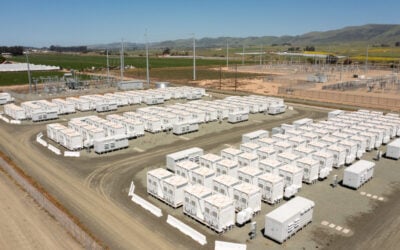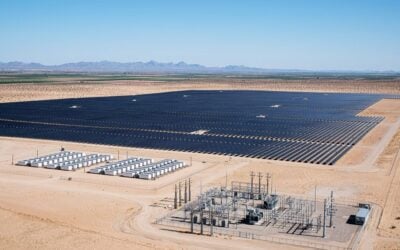
Another edition of our news in brief from around the world in energy storage, this time featuring Generac Grid Services, Eos Energy Enterprises and Malta Inc.
Generac Grid Services chosen by Dominion Energy Virginia
The business division set up by Generac to tap the virtual power plant (VPP) market has won a contract with utility Dominion Energy Virginia.
Enjoy 12 months of exclusive analysis
- Regular insight and analysis of the industry’s biggest developments
- In-depth interviews with the industry’s leading figures
- Annual digital subscription to the PV Tech Power journal
- Discounts on Solar Media’s portfolio of events, in-person and virtual
Generac Grid Services’ Concerto software platform has been selected as the distributed energy resources management (DERMS) control solution for Dominion Energy Virginia’s programmes of aggregating energy resources both behind-the-meter and in front-of-the-meter to provide services to the grid.
Generac Grid Services was launched after US generator and portable power solutions company Generac acquired distributed energy resources (DER) aggregation software provider Enbala. Generac also has its own range of battery storage systems.
Concerto will enable Dominion Energy Virginia to directly control DERs, including home battery and solar systems, electric vehicle (EV) charge units, smart thermostats and other customer-sited devices to serve as capacity resources. The utility will also use it to manage interaction of large-scale solar and storage with the grid.
The state of Virginia is targeting 100% renewable and emissions-free energy by 2045, in the process aiming for 3.1GW of energy storage by 2035 along the way – one of the US’ most ambitious targets – with Dominion Energy tasked with deploying or procuring a portion of that storage as one of Virginia’s major load-serving entities.
At the same time, at federal level, US regulator FERC’s FERC Order 2222 directs grid and market operators to allow DERs to participate in wholesale markets. That includes PJM Interconnection, the multi-state regional transmission organisation (RTO) that Dominion Energy Virginia wants to play aggregated DERs capacity into.
In August, Generac Grid Services signed a five-year contract with utility Arizona Public Service (APS) to provide capacity from energy stored in residential and commercial battery storage systems to the grid.
Eos’ zinc battery tech at industrial microgrid in California
An industrial microgrid has been inaugurated in Orange County, California, using 2MWh of zinc-based battery storage from Eos Energy Enterprises.
Microgrid developer Verdant Microgrid announced completion of the project yesterday at the site of customer ThermalVac Technologies’ metals processing and finishing facility.
The energy storage technology will allow ThermalVac to reduce its draw of power from the grid, particularly at peak times, in turn reducing a large portion of the Demand Charges that make up from roughly 25% to as much as 50% of commercial electricity bills in the US.
Four containerised Eos Znyth-brand aqueous zinc energy storage batteries adding up to 500kW of output are installed, each with four-hour storage duration.
Eos’ battery tech works by plating and replating zinc inside the cathode and the company claims that means abundant, low-cost materials that don’t include conflict minerals. The tech is aimed at markets for long-duration applications requiring between 4-12 hours storage and discharge.
Verdant noted that the Eos batteries were also eligible for California’s Self-Generation Incentive Program (SGIP) rebate incentive.
“The customer benefits from advanced battery technology through reduced demand charges on their site, which also provides several hours of resiliency in case of a power outage,” Verdant CEO Robert Babcock said.
“Eos’ batteries are made in America, are fully recyclable, non-flammable and provide a wide range of operating parameters that allows us to match the complicated customer load profile to minimise their demand charges.”
Eos claimed a few weeks ago in reporting its quarterly financial results that it had an order backlog as of that time worth US$457.3 million, having booked orders worth US$257.5 million during Q2 2022.
Energy-Storage.news reported this week on the completion of another industrial microgrid using non-lithium battery technology, with ESS Inc’s iron flow battery system installed at a tech waste handling facility in Pennsylvania.
DOE-backed prototype of Malta Inc’s ‘pumped heat’ storage tech
A laboratory-scale novel thermal ‘pumped heat’ energy storage system has been assembled and commissioned in a project supported by the US Department of Energy (DOE).
The system is a prototype of technology designed by Malta Inc, converting electricity into heat and storing it in molten salt, simultaneously running off cold energy which is stored in a liquid medium.
When discharging, the hot and cold energy are converted back into electricity using a heat engine powered by the temperature difference.
Applied science and tech R&D non-profit Southwest Research Institute (SWRI) has put together the lab-scale system, in a project supported with a US$2.6 million grant from ARPA-E, one of the DOE’s main centres for advancing innovation in energy.
Malta Inc’s technology, which the company calls Pumped Heat Energy Storage, could potentially be scaled up to very large scale >100MW projects with anywhere from eight hours to eight days of storage duration. The company has already attracted investment attention from the likes of Facebook founder Dustin Moskovitz, who participated in a 2021 Series B funding round worth US$50 million.
“SwRI is a leader in advanced power systems and has pursued extensive PHES research. With the potential for high system performance and its ability to be built anywhere, PHES is an extraordinarily promising energy storage technology,” SwRI machinery dept R&D director Tim Allison said.
Malta Inc believes its technology can become a low-cost solution to replacing the role of fossil fuel peaker plants at scale around the world. The next step in the SwRI pilot project will be to demonstrate the system’s operation, verify control system strategies for how to use it and to validate data to see if it does measure up to the technology provider’s expectations.
Utility Duke Energy is also currently evaluating the Malta technology, again with funding support from the DOE.






